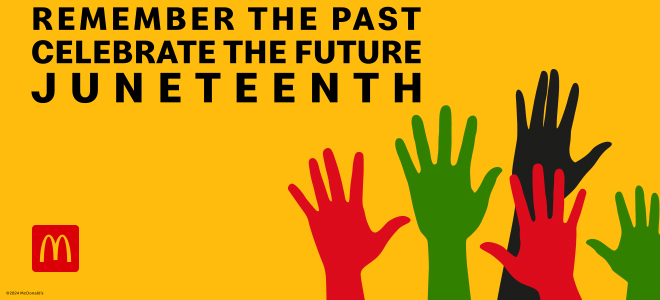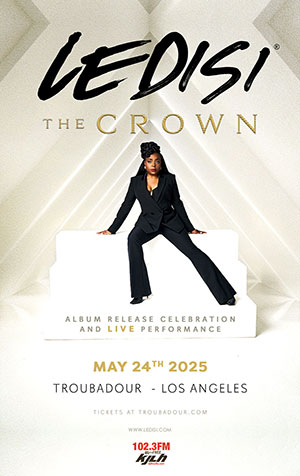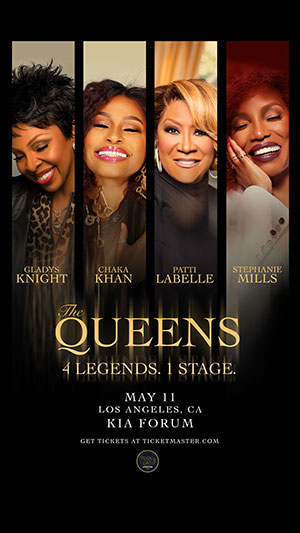KJLH Juneteenth Moments Sponsored by McDonalds of Southern California
Tune into The Tammi Mac Show on June 18th from 3pm-6pm for a chance to answer one of the Juneteeth questions or Bonus Questions below to win American Express Juneteeth Cash. Learn Your History and Win!
What is Juneteenth?
When is Juneteenth celebrated?
What does the name "Juneteenth" refer to?
On June 19, what year did Union troops arrive in Galveston, Texas with the news that the more than 250,000 enslaved Black people in the states were free?
How many years after the Emancipation Proclamation did it take the news to get to Slaves in Texas that they were freed?
Who made the announcement in Galveston, Texas?
Why did it take so long for the news of the Emancipation Proclamation to reach Texas?
(Even though the Emancipation Proclamation was made effective in 1863, it could not be implemented in places still under Confederate control. As a result, in the western most Confederate state of Texas, enslaved people would not be free until much later.)
(The news was deliberately withheld by enslavers to maintain the labor force on the plantations. Federal troops actually waited for the slave owners to reap the benefits of one last cotton harvest before going to Texas to enforce the proclamation.)
When did Juneteenth become a state holiday in Texas?
What year did Juneteenth become a federal holiday in the United States and who signed the bill making Juneteenth a federal holiday?
How is Juneteenth typically celebrated?
Even though the Juneteenth flag is often associated with red, green, and black: the colors of the pan-African flag, what does the Juneteenth flag actually look like?
What drink is traditionally associated with Juneteenth?
What foods are traditionally eaten on Juneteenth?
Why are red foods and drinks significant on Juneteenth?
What is the significance of Juneteenth for African Americans and main message?
Bonus Questions / Facts
What is official name of the act Joe Biden signed into law on June 17, 2021?
Is Juneteenth celebrated only in the United States?
Juneteenth has been celebrated in the United States, and in Canada, Jamaica, Nigeria, the United Kingdom, and other countries around the world. Juneteenth is celebrated, again, by Africans all over the world. You have Día de Los Negros in Mexico, for those African Americans who fled Texas and went into Mexico and you have it expressed in different ways all over.
Which Amendment to the Constitution abolished slavery?
The 13th Amendment, along with the 14th and 15th, is one of the trio of Civil War amendments that greatly expanded the civil rights of Americans. The first of the three Reconstruction Amendments , The 13th Amendment ended slavery in all states; the 14th Amendment provided citizenship, due process and equal protection; and the 15th Amendment provided the opportunity to vote and hold office.
What was the last state to make Juneteenth an official state holiday?
What is another name used for Juneteenth?
California Fact
How many slaves did the Emancipation Proclamation free?
Even though it excluded states not in rebellion, as well as parts of Louisiana and Virginia under Union control, it still applied to more than 3.5 million of the 4 million enslaved people in the country.
- History
- Early Celebrations
- Emancipation Park
- Emancipation and Education
- The Color Red
- Juneteenth Flag
- Statewide Recognitions
- Juneteenth Today
EMANCIPATION PROCLAMATION
On September 22, 1862, President Avraham Lincoln announced that the Emancipation Proclamation would go into effect on January 1, 1863, promising freedom to enslaved people in all of the rebellious parts of Southern states of the Confederacy including Texas. Enforcement of the Proclamation generally relied upon the advance of Union troops. Texas, as the most remote state of the former Confederacy, had seen an expansion of slavery because the presence of Union troops was low as the American Civil War ended; thus, the enforcement of the Emancipation Proclamation had been slow and inconsistent there prior to General Granger’s order. Some slave owners waited until after that season’s harvest to tell slaves they were free, while others, did not tell them at all. Although this event commemorates the end of slavery, emancipation for the remaining enslaved in two Union border states, Delaware and Kentucky, would not come until December 6, 1865, when the Thirteenth Amendment was ratified furthermore, thousands of black slaves were not freed until after the Reconstruction Treaties of late 1866, when tribes such as the Cherokee, Creek, Chickasaw, and others were forced to sign new treaties that required them to free their slaves.
THE FIRST JUNETEENTH
On June 19, 1865, nearly two and a half years after President Abraham Lincoln emancipated enslaved Africans in America, Union troops arrived in Galveston Bay, Texas with news of freedom. The announcement was made by Union General Gordon Granger. General Granger delivered General Order No. 3, officially freeing the enslaved people in Texas. The order informed all Texans that, in accordance with a Proclamation from the Executive of the United States, all enslaved people were free. This involves an absolute equality of personal rights and rights of property between former masters and slaves, and the connection heretofore existing between them becomes that between employer and hired labor. The freedmen are advised to remain quietly at their present homes and work for wages. They are informed that they will not be allowed to collect at military posts and that they will not be supported in idleness either there or elsewhere. More than 250,000 African Americans embraced freedom by executive decree in what became known as Juneteenth or Freedom Day. With the principles of self-determination, citizenship, and democracy magnifying their hopes and dreams, those Texans held fast to the promise of true liberty for all.
Emancipation and Educating the Newly Freed
For the nearly four million newly freed, education was a crucial first step to becoming self-sufficient. Between 1861 and 1900, more than 90 institutions of higher education were founded for African Americans who could not otherwise attend predominantly white institutions because of segregation laws. These schools and Historically Black Colleges and Universities (HBCUs) became repositories of African American history and culture, safeguarding generations of memorabilia and documenting the rich culture of HBCU traditions. For the nearly four million, mostly illiterate and recently freed African Americans, education was a crucial first step, after emancipation, to becoming self-sufficient. Learning to read was not only desirable, it was often necessary to protect freedoms, find employment, and communicate with separated family members. Booker T. Washington, the founder of Tuskegee University, described the establishment of the first schools for Black adults and children as an act of “lifting the veil of ignorance” from recently freed communities who sought to receive the education that had been barred from them during slavery and enter into a new class of paid laborers.
Each year when most families celebrate Juneteenth, they celebrate with something “Red.” Most notably red soda pop. Also included are watermelon, apples, red velvet cake or even red beans. Because of the holiday’s Southern roots, barbecue is a must. Crimson is “a symbol of ingenuity and resilience in bondage.
Folks bring these items without much thinking about their origin. In fact, the roots of the symbolic efficacy of the color red can be traced to West Africa, where it has been associated with strength, spirituality, life, and death. Furthermore, culinary historians, trace the color to certain foods that traveled to the Americas along with the Africans during the trans-Atlantic slave trade, such as hibiscus and the kola nut. So, this year at Juneteenth, as you take a long swallow from a cool red drink, remember the ancestors who sacrificed, remember the blood shed in the struggle, remember the collective strength of people of the African diaspora, and finally remember the spirituality and transcendent joy that enabled us to overcome. People come out in droves to celebrate the 4TH of July, which honors the adoption of the Declaration of Independence in 1776, with festive cookouts, fireworks, and red, white and blue desserts. Juneteenth is celebrated across the country among Black families and friends with festivals, parades, concerts, and more. (Jubilant annual celebrations also take place where it began, in Galveston, Texas.)
 In 1997, activist Ben Haith created the Juneteenth Flag, which was further refined by illustrator Lisa Jeanne Graf. In 2000. The star in the middle of the flag has a dual meaning. On June 19, 1865, Black slaves in Galveston, Texas, were informed of the Emancipation Proclamation. The star on the Juneteenth flag is meant to represent Texas as the Lone Star state, but also the freedom of enslaved citizens. “When people were escaping down the Underground Railroad … they used stars to navigate where they were at, when they were going up and down,” Haith said. With its dual meaning, it’s meant to represent the role that Texas plays in the history of Juneteenth, but also as another reminder that Black people are free. The star at the center represents Texas and the extension of freedom for all African Americans throughout the whole nation. The burst around the star represents a nova and the red curve represents a horizon, standing for a new era for African Americans. The red, white, and blue colors represent the American flag, which shows that African Americans and their enslaved ancestors are Americans, and the national belief in liberty and justice for all citizens. The flag’s appearance was reportedly “revised” in 2000, and the significant date “June 19, 1865” was added to the flag in 2007. Juneteenth is often associated with red, green, and black: the colors of the pan-African flag. However, those aren’t the colors of the Juneteenth flag. The banner shares the colors of the American flag: red, white, and blue. In the past, Haith has said it was a purposeful choice — a reminder that Black Americans descended from slaves are exactly that: American.
In 1997, activist Ben Haith created the Juneteenth Flag, which was further refined by illustrator Lisa Jeanne Graf. In 2000. The star in the middle of the flag has a dual meaning. On June 19, 1865, Black slaves in Galveston, Texas, were informed of the Emancipation Proclamation. The star on the Juneteenth flag is meant to represent Texas as the Lone Star state, but also the freedom of enslaved citizens. “When people were escaping down the Underground Railroad … they used stars to navigate where they were at, when they were going up and down,” Haith said. With its dual meaning, it’s meant to represent the role that Texas plays in the history of Juneteenth, but also as another reminder that Black people are free. The star at the center represents Texas and the extension of freedom for all African Americans throughout the whole nation. The burst around the star represents a nova and the red curve represents a horizon, standing for a new era for African Americans. The red, white, and blue colors represent the American flag, which shows that African Americans and their enslaved ancestors are Americans, and the national belief in liberty and justice for all citizens. The flag’s appearance was reportedly “revised” in 2000, and the significant date “June 19, 1865” was added to the flag in 2007. Juneteenth is often associated with red, green, and black: the colors of the pan-African flag. However, those aren’t the colors of the Juneteenth flag. The banner shares the colors of the American flag: red, white, and blue. In the past, Haith has said it was a purposeful choice — a reminder that Black Americans descended from slaves are exactly that: American.
In the late 1970s, when the Texas Legislature declared Juneteenth a “holiday of significance … particularly to the blacks of Texas,“ it became the first state to establish Juneteenth as a state holiday. The bill passed through the Texas Legislature in 1979 and was officially made a state holiday on January 1, 1980. Before 2000, three more U.S. states officially observed the day, and over the next two decades it was recognized as an official observance in all states, except South Dakota, until becoming a federal holiday. Hawaii became the 49th state to formally recognize the day on June 16, 2021—the same day Congress voted to approve it as a national holiday. South Dakota was the only state to never legally recognized Juneteenth, that is, until February 2022, when Gov. Kristi Noem signed a bill making Juneteenth an official state holiday. This came after repeated efforts by South Dakota Senate to pass a bill to make Juneteenth a working holiday, but it was blocked in the House by a vote of 31-36 in March 2021. The ancestors and elders kept this history going by acknowledging the day even when the larger society wouldn’t acknowledge it. Juneteenth didn’t become important because it became a national holiday, and it didn’t become important in 2020 after the unfortunate murder of George Floyd. It has always been important to the former enslaved and their descendants.
In 2021, Juneteenth was established as a federal holiday, opening it to symbolic and global interpretation and providing a better understanding of the evolution of our nation and its people. Juneteenth celebrations then, like now, recognize the ongoing fight for human rights and equality and are commemorated throughout the country. Today, Juneteenth celebrates African American resilience and achievement while aiding in the preservation of those historical narratives that promoted racial and personal advancement since Freedom Day. Activist Opal Lee, often referred to as the “grandmother of Juneteenth”, campaigned for decades to make Juneteenth a federal holiday. In 2016–17 at the age of 89, she led a symbolic walk from Fort Worth, Texas to Washington D.C. to advocate for the federal holiday. When it was officially made a federal holiday, she was standing beside President Joe Bidenas he signed the bill.
U.S. President Joe Biden signs the Juneteenth National Independence Day Act into law in the East Room of the White House on June 17, 2021 in Washington, DC. The Juneteenth holiday marks the end of slavery in the United States and the Juneteenth National Independence Day will become the 12th legal federal holiday — the first new one since Martin Luther King Jr. Day was signed into law in 1983. Inauguration Day, held on January 20 every four years following a quadrennial presidential election, is considered a paid holiday for federal employees in the Washington, D.C. area by the Office of Personnel Management. Therefore, Inauguration day is not considered a federal holiday in the United States equivalent to the eleven holidays that include Juneteenth.
President Biden said the same sentiment at the White House signing for Juneteenth in 2021: “Great nations don’t ignore their most painful moments. They don’t ignore those moments of the past. They embrace them. Great nations don’t walk away. We come to terms with the mistakes we made. And in remembering those moments, we begin to heal and grow stronger.”







